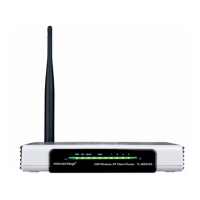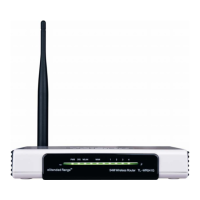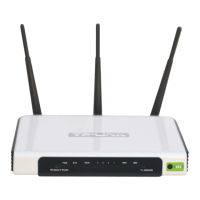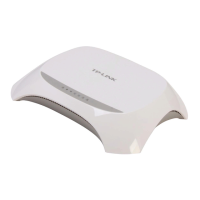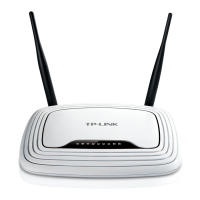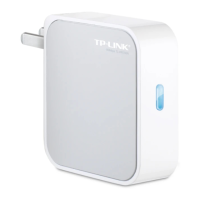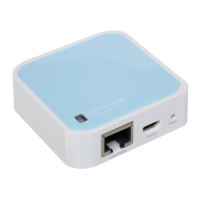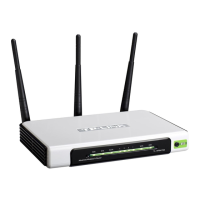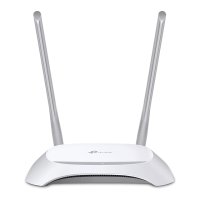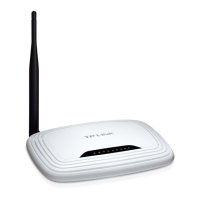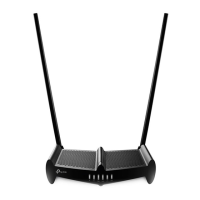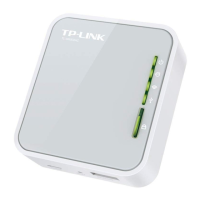Do you have a question about the TP-Link TL-WR542G and is the answer not in the manual?
Statement on FCC RF radiation exposure limits and compliance requirements for mobile configurations.
Explains how the router TL-WR542G is referred to throughout the guide for consistency.
Introduces the TL-WR542G 54Mbps Wireless Router, its integrated functions, and SOHO network solutions.
Details the router's compliance with IEEE standards, ports, extended range technology, and security features.
Explains the layout of the router's front and rear panels and the function of its LEDs.
Outlines the broadband access, modem, PC adapter, protocol, and web browser requirements for router setup.
Details the environmental conditions for router installation, including temperature, humidity, and ventilation.
Provides a step-by-step guide to physically connect the router to the modem and PCs.
Details manual and automatic TCP/IP configuration methods for PCs connecting to the router.
Guides users through the router's web-based utility for initial setup and internet connection.
Explains the process of logging into the router's web-based utility using default credentials.
Details the read-only status information displayed for LAN, Wireless, WAN, and System Up Time.
Outlines the submenus within the Network configuration: LAN, WAN, and MAC Clone.
Explains how to clone a PC's MAC address to the router's WAN port, often required by ISPs.
Outlines submenus for wireless configuration: Wireless Settings, MAC Filtering, and Wireless Statistics.
Covers DHCP settings, client lists, and address reservation for network configuration.
Outlines submenus for network traffic forwarding: Virtual Servers, Port Triggering, DMZ, and UPnP.
Outlines submenus for security settings: Firewall, IP Filtering, Domain Filtering, MAC Filtering, Remote Management, Advanced Security.
Covers binding settings and ARP list for managing IP and MAC address associations.
Allows adding or deleting static routes for network traffic path determination.
Explains DDNS for assigning a fixed domain name to a dynamic IP address for hosting services.
Covers system tools like Time, Firmware, Factory Defaults, Backup/Restore, Reboot, Password, Log, and Statistics.
Guides ADSL users on configuring the router for internet access using PPPoE connection mode.
Guides Ethernet users on configuring the router for internet access using Dynamic IP.
Details configuration steps for using Netmeeting, including Virtual Server or DMZ Host setup.
Explains how to configure a WEB server by changing the management port to avoid conflicts.
Provides troubleshooting steps for wireless stations unable to connect to the router.
Guides on installing the TCP/IP component on Windows XP via Control Panel.
Details how to automatically obtain IP/DNS or manually set IP and DNS addresses in Windows XP.
Statement on FCC RF radiation exposure limits and compliance requirements for mobile configurations.
Explains how the router TL-WR542G is referred to throughout the guide for consistency.
Introduces the TL-WR542G 54Mbps Wireless Router, its integrated functions, and SOHO network solutions.
Details the router's compliance with IEEE standards, ports, extended range technology, and security features.
Explains the layout of the router's front and rear panels and the function of its LEDs.
Outlines the broadband access, modem, PC adapter, protocol, and web browser requirements for router setup.
Details the environmental conditions for router installation, including temperature, humidity, and ventilation.
Provides a step-by-step guide to physically connect the router to the modem and PCs.
Details manual and automatic TCP/IP configuration methods for PCs connecting to the router.
Guides users through the router's web-based utility for initial setup and internet connection.
Explains the process of logging into the router's web-based utility using default credentials.
Details the read-only status information displayed for LAN, Wireless, WAN, and System Up Time.
Outlines the submenus within the Network configuration: LAN, WAN, and MAC Clone.
Explains how to clone a PC's MAC address to the router's WAN port, often required by ISPs.
Outlines submenus for wireless configuration: Wireless Settings, MAC Filtering, and Wireless Statistics.
Covers DHCP settings, client lists, and address reservation for network configuration.
Outlines submenus for network traffic forwarding: Virtual Servers, Port Triggering, DMZ, and UPnP.
Outlines submenus for security settings: Firewall, IP Filtering, Domain Filtering, MAC Filtering, Remote Management, Advanced Security.
Covers binding settings and ARP list for managing IP and MAC address associations.
Allows adding or deleting static routes for network traffic path determination.
Explains DDNS for assigning a fixed domain name to a dynamic IP address for hosting services.
Covers system tools like Time, Firmware, Factory Defaults, Backup/Restore, Reboot, Password, Log, and Statistics.
Guides ADSL users on configuring the router for internet access using PPPoE connection mode.
Guides Ethernet users on configuring the router for internet access using Dynamic IP.
Details configuration steps for using Netmeeting, including Virtual Server or DMZ Host setup.
Explains how to configure a WEB server by changing the management port to avoid conflicts.
Provides troubleshooting steps for wireless stations unable to connect to the router.
Guides on installing the TCP/IP component on Windows XP via Control Panel.
Details how to automatically obtain IP/DNS or manually set IP and DNS addresses in Windows XP.
| Interface | IEEE 802.11g, IEEE 802.11b |
|---|---|
| Input current | 0.8 A |
| xDSL connection | No |
| Dimensions (WxDxH) | 174 x 111 x 30 mm |
| Power requirements | AC 9 V |
| Supports ISDN connection | Yes |
| Ethernet LAN (RJ-45) ports | 5 |
| Product color | Black, White |
| Storage temperature (T-T) | -40 - 70 °C |
| Operating temperature (T-T) | 0 - 40 °C |
| Storage relative humidity (H-H) | 5 - 90 % |
| Operating relative humidity (H-H) | 10 - 90 % |
